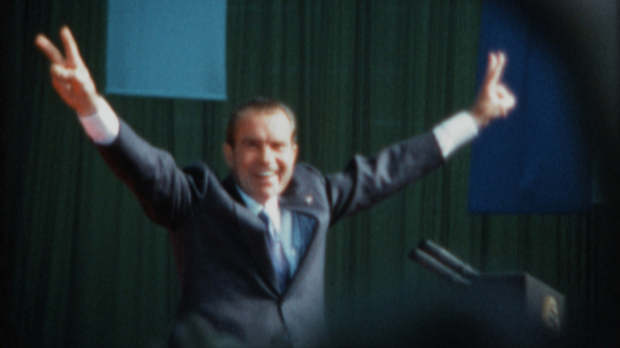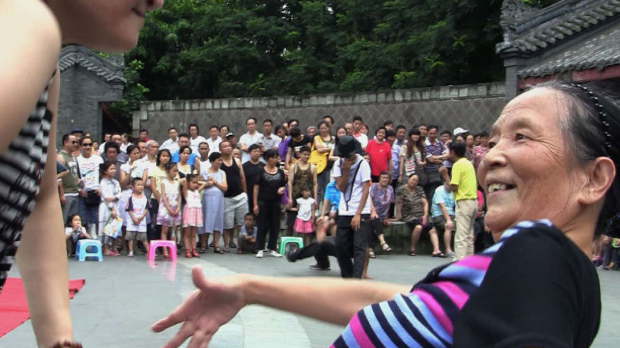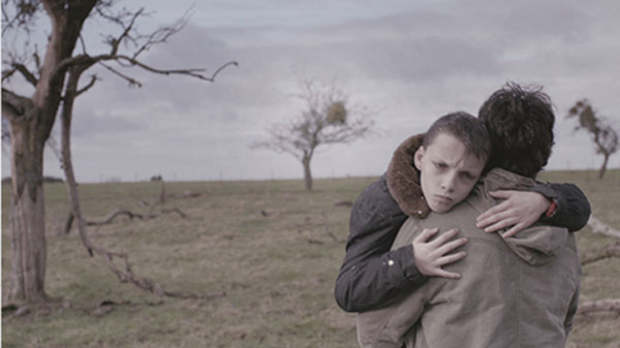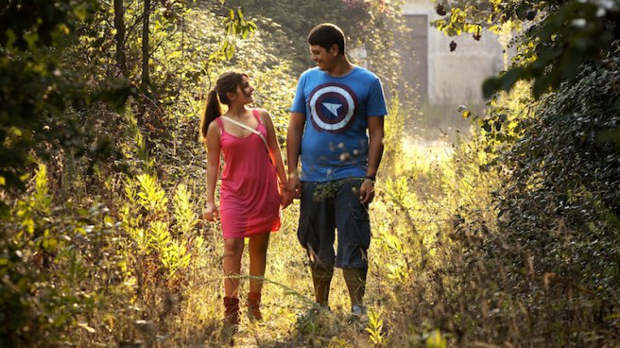 Back to selection
Back to selection
Rear-Ended: New Directors/New Films

If brave new fiction dominated the first week of New Directors/New Films, a cluster of divergent docs owns the second. Some of the docmakers aim for the intimate and personal (Stories We Tell, Anton’s Right Here); others, the extroverted and novel (Our Nixon, People’s Park). For the most part, grasp equals reach. The directors merge form and content in ways appropriate for both subject and audience.
The one standout feature fits nicely with the docs. The Interval is a study in doc-like realism, and Italian director Leonardo Di Costanzo is a veteran of documentaries. The film has a light poetic feel as well — not surprisingly, since its homeland has a long, shining history of such commingling. It may be low-budget and a two-hander with only six characters in toto, yet it towers over the week’s other fiction.
Unfortunately, several of these are annoyingly pretentious, or at least overly mannered. Two others are so plain silly, with little redemption in the way of style, that their inclusion adds a bitsy blot to the rep of such a highly regarded festival.
Below, in no particular order, are the most compelling of the films on view through the weekend. At press time, I have watched all of the features except for the much-hyped Upstream Color.
TRICKY DOCS
OUR NIXON (Penny Lane, U.S.)
To those on to him, Richard M. Nixon was “Tricky Dick.” One of the many pathetic ironies in Lane’s spectacular film is the pathologically paranoid Nixon’s private accusations of McCarthyism against the newspapers (Washington Post, New York Times) that were dutifully documenting his abuse of power, most notably in the infamous break-in at the DNC offices in the Watergate. Many who followed political news during the two decades prior to his election to the presidency in 1968 were aware how he himself had embraced McCarthyism, relying on its smarmy tactics as early as 1946 when he ran for a seat from California in the House of Representatives, and won.
Lane and astute editor Francisco Bello chose wisely from the vast archives they were privy to. They assembled contemporary TV footage; highlights from the plethora of home movies shot by top aides and film buffs J.R. Haldeman, John Ehrlichman, and Dwight Chapin; interviews with the three men years after they and their boss, like ducks in a row, fell in disgrace; and, most repugnant and pathetically funny of all, excerpts from the secret White House tapes he fought to keep away from Watergate investigators and a public that had reelected him in a landslide, even as the criminal acts were being exposed.
Among the choice sections are audio in which Nixon, a master of selective recall, tells Ehrlichman on the phone that he had no knowledge of an earlier illicit intrusion, this one at the office of Daniel (Pentagon Papers) Ellsberg’s psychiatrist, then backing down once his senior aide reminded him that in fact he did; and a classic Nixonian pronouncement during the course of a discussion with his closest advisors about the respectful treatment of homosexuality on an episode of All in the Family: “The last six emperors of Rome were fags.” Hmm, well, Valley of the Dolls had been a recent bestseller.
Lane and co-producer/co-screenwriter Brian L. Frye don’t opt for an easy indictment of the man. The film includes footage from his groundbreaking China trip (shots of his meeting with Mao linger in the mind); scenes from the triumphant Apollo mission that landed Alan Shepard on the moon (“one small step…”); and social occasions both political (an enamored Chapin shot all of the heads of state they encountered) and personal, especially older daughter Tricia’s wedding.
At the beginning of a performance by the Ray Conniff Singers (“I know they’re square, but so am I”) at that formal White House affair, a member unfurls a white banner that reads “No more killing,” and chides the head of state over a mic in front of his guests. Amazingly, during subsequent schmaltzy numbers, she stays in position. Were there had been more like her, openly defying a president who assures the country on national television that the increasing protests against the Vietnam War would have no effect on his hawkish policies.

STORIES WE TELL (Sarah Polley, Canada)
The actor/director appears infrequently, mostly behind a mixing board, in this nakedly intimate doc about her late mom and her own quest to find out if her “father” is her “real” parent or an unaware pretender. In the film’s nicks and crevices is an extended essay on the “stories we tell,” and in fact the stories we don’t tell, about our own and our loved ones’ personal narratives, and the reliability of memory in the course of doing so. One of Polley’s more productive interviewees tells her it’s impossible to make a film about her mother using multiple points-of-view, which he compares to concentric circles less and less significant the further away you get from the center, from the subject.
She does not heed his advice. All of those she talks to shed light on what had been an enigma to her: the vivacious storm of an actress and casting agent named Diane Polley, whose high-energy multitasking often left chaos in its wake, and who died when late-in-life baby Sarah was just 11.
After quoting at the beginning of the doc from Margaret Atwood’s novel Alias Grace (making that into a historical-fiction film about a female criminal is Polley’s next project), she tracks her process, what she calls an “investigation,” going from a confused young woman living “in the middle of a story” to a knowing soul after resolving its questions, and it “becomes anything like a story when you’re telling it to yourself or to someone else.” She tells it to both: She finds answers computing new information in her own mind, then passes on deep, buried discoveries to us.
I have never seen a film quite like this. Its marriage of poignancy and technical proficiency is superbly orchestrated (some argue a bit too much, with an abundance of self-congratulation, but frankly, articles I’ve seen that take this position are mostly by fellow Canadians, typical of journos’ reactions to home-bred talent in English-speaking countries that look more to the U.S. for cinematic sustenance and validation). She intercuts old home movies with staged reconstructions, shots and stills of Diane performing, and recent interviews.
The most affecting is with her beloved dad, British actor-turned-insurance salesman Michael Polley, who reads from a manuscript he wrote describing his late wife and detailing their relationship. Sarah speaks with siblings, step-siblings, and Mum’s pals, professional colleagues, and suspected lovers, who are unknowing candidates for the role of biological dad. No giveaways here, but the journey is rich, engaging, and suspenseful, the film a bright feather in her directorial cap.

PEOPLE’S PARK (Libbie B. Cohn, J.P. Sniadecki, U.S.)
Gimmick, appropriate formal strategy, or both? The conceit of this 78-minute doc is that it is but a single shot. On a hot Saturday afternoon in Chengdu, administrative capitol of Sichuan in southwest China, Sniadecki pushes Cohn, sitting in a wheelchair — a makeshift dolly — in an uninterrupted serpentine walk through the park, so to speak, along pathways filled with locals shuffling along, or circling the edges of areas in which they engage in, or observe, a variety of amateur spectacles and other diversions.
A product of the Sensory Ethnography Lab at Harvard, the film is an exercise in cultural anthropology and possibly an indirect challenge to the field’s nemesis, the Heisenberg Principle. The duo do not attempt to mask their presence. Parkgoers acknowledge them with looks of mild curiosity, if at all, although a few actually perform for the camera.
The most stunningly outrageous example is a slew of women dancing wildly to quasi-rock music broadcast loudly over loudspeakers. No conventional beauties these, but an array of ordinary, sometimes eccentrically attired females shaking their breasts and thrusting whatever parts of the bodies are thrustable. Each has her own let-it-all-hang-out style — a far cry from the tightly controlled ballet in the propagandistic stage piece The Red Detachment of Women, which Premier Zhou Enlai showed visitor Richard Nixon more than 40 years ago.
The film is lovely, the intense greens of the grass and the browns of tree trunks a fine manicured backdrop for the unmatched ensembles and wide demographic of passersby in the directors’ way. Chengdu is renowned for its laid-back lifestyle, and the unhurried pace and play in the park confirm its reputation. Each person they encounter becomes part of a natural, democratic mise-en-scene.
What has been called “revolutionary cinema” has traditionally had at its core abutting shots that make up “radical” montages. People’s Park proffers the reverse, an attempt to capture a relatively new society with contiguity and continuity. The filmmakers don’t seem to give a hoot about the oft-discussed ideology of choice—camera height and angle, etc. They get what they get, and at the same time provoke debate about their chosen technique.

ANTON’S RIGHT HERE (Lyubov Arkus, Russia)
He refers to himself in the third person, always with both first and last names. He identifies people in photographs by their full names and attaches a color to each. From this information, many understand that Russian teen Anton Kharitonov is autistic. His mother, Rita, raised him alone — his father had made it clear that he had moved on to a new family — and by the time critic-turned-director Lyubov Arkus met him seven years after she read his precocious writings, he had changed from productive child into withdrawn adolescent, most at ease under a blanket.
She began filming him during a beach sojourn, after persuading the distant boy to write in the sand. His compliance turned into a mutual bond. He could interact with only one person at a time, so a tremendous responsibility fell upon her — one that she adhered to off and on for several years. The film is crude if immediate, and you can’t help but wonder if she kept up the relationship as much to round out her debut project as to help the boy.
And help he needed. No team player, he was tossed out of the one progressive camp in Russia, Svetlana, where volunteers live and work with the afflicted. After the prolonged death of his mother, Anton lived in several horrid psychiatric hospitals. Arkus shoots many of them and notes their incompetence: overdrugging and withholding affection, among other offenses. In one sequence, out of necessity and perhaps vanity, after she and d.p. Alisher Khamidkhodzhaev sneak Anton out of the worst of them, she proclaims to the camera, “We have kidnapped the child!”
With the assistance of others, Anton’s living conditions improve. To reveal too much of his progress would undermine the satisfaction of having curiosity sated. Arkus is a polished manipulator, at first evoking sympathy for the sick and worried mother, then ennobling the “overworked’ father who had abandoned wife and son. As engaging as this documentary is, you can’t help but wonder how a veteran film critic could make a doc that does not trust its audience.

THE GOLD OF NAPLES
THE INTERVAL (Leonardo Di Costanzo, Italy)
A vast, abandoned psychiatric hospital in Naples, its overgrown gardens walled in on four sides, is the setting for the perfunctory day-long encounter between two teens who detest being there. This is not a conventional jail but a convenient enclosure for two local Camorra leaders to hold against her will rebellious Veronica (Francesca Riso), a sexually active 15-year-old who is “guilty” of transgression: She disregarded the unwritten mob rule against fraternizing with boys from nearby “enemy” neighborhoods.
Salvatore, aka Toto (Alessio Gallo), is an unworldly 17-year-old granita vendor forced to play warden during the “interval” between his father’s closing the grounds’ gates behind him in the early morning until his return with his beverage cart the same night. (Both teens are non-pros from the area who attended a summer acting workshop.) After the dad’s departure, one of the gangsters, something of a macho poseur, enters and explains to the chubby, unwilling jailer his responsibilities, without spelling out the reason Veronica is a prisoner in his charge. After dark, he and his boss, a fake intellectual, arrive on their motorcycles to tame the girl’s nonconformist streak, then to collect her. Her fate? Hinted at by Di Costanzo but not revealed. Once again, Salvatore is clueless.
The beginning of Veronica and Salvatore’s caged waltz is unpromising: She makes nasty, degrading comments, he ignores her. After they declare an unofficial truce, the multiple rooms and open spaces of the gutted, rat-infested building become an imaginary playground in which they invent amusements to pass the time. The film is nothing if not architectonic. Di Costanzo follows their movements, which often echo the interior contours of the edifice.
Outside of the magical world they have created, their sole escape hatch is merely a view of tall buildings nearby that have only recently gone up. These foreign structures are changing the complexion of the inner city in which the two are both prisoners of a sort. Salvatore explains that the basement is flooded on account of their pressure on the water table. Yet they create a fantasy from the damage, hopping into a stored rowboat for a round of verbal games. They laugh, but the joy is short-lived for these no-hopers that Di Costanzo and co-screenwriters Maurizio Braucci (Gomorrah) and Mariangela Barbanente have so remarkably sketched.
